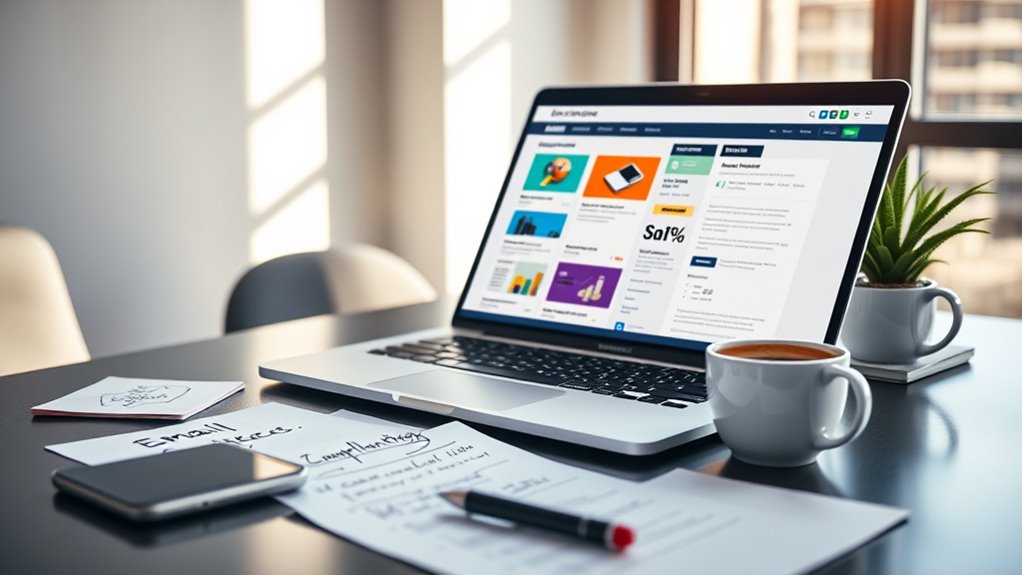Email marketing is a powerful way to connect with your customers through personalized and targeted messages. It builds relationships, boosts sales, and encourages loyalty by delivering relevant content based on behaviors, preferences, or demographics. Using automation tools, you can send timely follow-ups and nurture leads effortlessly. Combining segmentation and automation creates a seamless experience that increases engagement and delivers better results. Keep exploring to discover how these strategies can transform your business communication.
Key Takeaways
- Email marketing builds customer relationships and boosts sales through targeted, personalized communication strategies.
- Segmentation divides audiences by behaviors or demographics to deliver relevant content and improve engagement.
- Automation tools streamline campaigns, enabling timely, personalized messages like welcome emails and cart reminders.
- Combining segmentation and automation increases engagement, strengthens loyalty, and enhances return on investment.
- Effective email marketing turns campaigns into meaningful conversations, supporting business growth and customer retention.

Have you ever wondered how businesses stay connected with their customers so effectively? The secret often lies in well-executed email marketing, a powerful tool for building relationships and boosting sales. The foundation of successful email campaigns begins with understanding segmentation strategies. Instead of blasting generic messages to everyone, segmentation allows you to divide your audience into specific groups based on their behaviors, preferences, or demographics. This targeted approach guarantees that each recipient receives content that resonates with their interests, increasing engagement and conversion rates. For example, you might segment your list by past purchase history, location, or engagement level, tailoring your messages accordingly. This personalized touch makes your communications feel more relevant and valuable, encouraging recipients to open, read, and act on your emails. Additionally, understanding anime movies can inspire creative themes or visuals for your email campaigns, making them more engaging for diverse audiences.
To efficiently manage multiple segments and send timely, personalized messages, automation tools are indispensable. These tools streamline your email marketing efforts by automating routine tasks like sending welcome emails, follow-ups, or cart abandonment reminders. Once set up, automation means you don’t have to manually craft each message or worry about forgetting to send an essential email. Instead, your automation platform handles it all behind the scenes, freeing you to focus on crafting compelling content and analyzing results. Automation tools also enable drip campaigns—sequences of targeted emails that nurture leads over time—helping you stay top of mind without constant oversight. Plus, with real-time analytics, you can track how different segments respond, allowing you to refine your segmentation strategies and optimize future campaigns.
Using automation tools alongside segmentation strategies creates a seamless, personalized experience for your audience. When your emails are tailored to each recipient’s preferences and behaviors, they’re more likely to engage, click, and convert. This approach not only improves your return on investment but also fosters trust and loyalty among your customers. As you grow more familiar with your audience’s needs through data insights, you can continually refine your segmentation and automation tactics, making your email marketing efforts more effective over time. The combination of strategic segmentation and automation tools transforms your email campaigns from generic messages into powerful conversations. Ultimately, this results in stronger customer relationships, increased sales, and a more efficient marketing process—proof that email marketing isn’t just a simple tool but a essential component of your overall business strategy.
Frequently Asked Questions
How Do I Build an Effective Email List From Scratch?
To build an effective email list from scratch, start with compelling lead magnets that attract your target audience. Focus on list building strategies like pop-ups, landing pages, and social media promotions. Once you have subscribers, use audience segmentation to send personalized content, increasing engagement and conversions. Always guarantee your sign-up process is simple and transparent, encouraging trust and ongoing subscription growth.
What Are the Legal Requirements for Email Marketing?
You need to play by the rules to stay out of hot water. Make sure you obtain clear consent from recipients before sending emails, complying with consent regulations. Also, include privacy policies that explain how you handle their data. Always give recipients an easy way to unsubscribe, and keep detailed records of permissions. This way, you protect your business and build trust with your audience, turning contacts into loyal customers.
How Can I Personalize Emails Without Seeming Intrusive?
You can personalize emails without seeming intrusive by using customer data thoughtfully. Focus on relevant details like purchase history or preferences to craft tailored content. Implement personalization strategies such as addressing recipients by name or recommending products based on their browsing behavior. Keep your tone friendly and genuine, avoiding over-sharing. This approach shows you value their interests, making your emails feel helpful and personalized rather than invasive.
What Metrics Should I Track to Measure Success?
Think of your email campaign as a garden—you need the right tools to see it flourish. Focus on tracking engagement rates and open metrics, as they reveal how your audience interacts with your content. Higher engagement indicates your emails resonate, while open rates show your subject lines’ effectiveness. Keep an eye on these metrics, and you’ll know when to nurture your campaign for maximum growth.
How Often Should I Send Marketing Emails?
You should send marketing emails 1 to 4 times a week, depending on your audience’s preferences. Keep your email frequency consistent to maintain audience engagement without overwhelming them. Pay attention to open and click-through rates; if engagement drops, consider reducing your email frequency. Testing different schedules helps you find the ideal balance, ensuring your emails stay relevant and your audience remains interested without feeling spammed.
Conclusion
Now that you know the power of email marketing, it’s clear why your business needs it. Just like a well-timed inbox message can turn a casual browser into a loyal customer, a simple email can spark unexpected growth. When you harness this tool effectively, you might find that success arrives just when you least expect it—proof that the right strategy, at the right time, truly makes all the difference. Don’t wait—start your email journey today.










